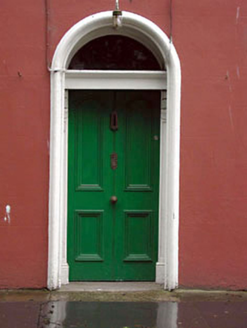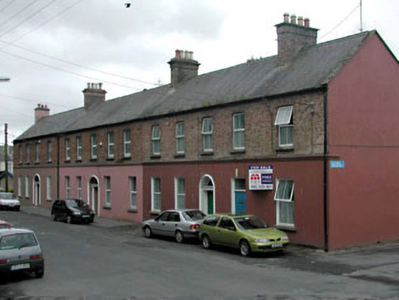Survey Data
Reg No
11816111
Rating
Regional
Categories of Special Interest
Architectural, Historical, Social
Previous Name
Monasterevin Garda Síochána Station
Original Use
House
In Use As
House
Date
1840 - 1850
Coordinates
262588, 210665
Date Recorded
28/01/2003
Date Updated
--/--/--
Description
End-of-terrace five-bay two-storey house, c.1845, on a corner site possibly double pile with round-headed door opening to ground floor. In use as Garda Síochána Station, 1939. Renovated, c.1920, with additional door opening inserted to ground floor. Refenestrated, c.1990. Now returned to residential use. Gable-ended roof with slate. Clay ridge tiles. Red brick chimney stacks. Rendered coping to gables. Cast-iron rainwater goods. Rendered walls to ground floor. Painted. Moulded rendered stringcourse to first floor. Yellow brick Flemish bond wall to first floor. Washed. Rendered walls to side (north-west) elevation. Painted. Square-headed window openings. Stone sills. Replacement uPVC casement windows, c.1990. Round-headed door opening. Moulded rendered surround. Timber pilaster doorcase with decorative consoles. Timber panelled door. Overlight. Square-headed door opening, c.1920. Timber panelled door. Overlight. Road fronted on a corner site. Concrete footpath to front.
Appraisal
This house, built as one of a group of three similar houses and possibly originally built as a Royal Irish Constabulary barracks, is a fine and substantial edifice composed of graceful balanced proportions centred about a fine doorway with Classically-inspired doorcase. Originally built on a symmetrical plan, the insertion of an additional door opening to ground floor in the early twentieth century has detracted somewhat from the original harmony of the design. The house has been well maintained to present an early aspect and retains most of its original features and materials – the replacement windows are not in keeping with the original integrity of the design and the re-instatement of traditional timber fenestration would restore a more accurate representation of the original appearance. The house is of social and historical interest for its former use as a Royal Irish Constabulary barracks/Garda Síochána station, and therefore one of the earliest civic buildings in the locality. The house, together with the neighbouring buildings to south-east (11816077, 110/KD-26-16-77, 110), is an attractive feature on the streetscape of Drogheda Street, forming the corner leading on to Whelan’s Row to the south-west, and is distinguished by the juxtaposition of render and red brick in the construction.



